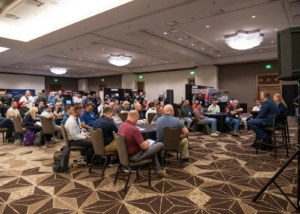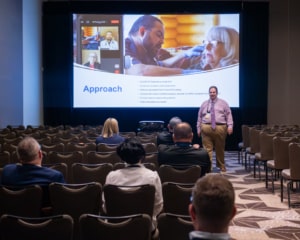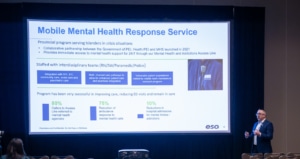Wave 2024 Recap: Top 6 Key Topics in EMS & Fire Industries
From April 2-5, the top fire services and EMS industry thought leaders and data analysts gathered at Wave 2024 to share what trends they’re forecasting for both fields and how they’re enacting change within their own organizations through the power of data-driven insights. Throughout the entire ESO-sponsored four-day conference, many impactful topics were discussed, and six major themes emerged. Check out the list below to get a better look at what big ideas and changes are shifting both industries:

1. Data-driven advancements
While one of the most obvious themes of at a data-focused conference is, in fact, data-driven advancements, it is impossible to ignore the powerful effect that having these insights has on both industries. Data is being put front-and-center in the fire services industry with the implementation of the new National Emergency Response Information System (NERIS) by the U.S. Fire Administration. In Modernizing Fire & All-Hazards Incident Data and Analysis with NERIS by Rebecca Harned, Advisor, U.S. Fire Administration, Federal Emergency Management Agency, we were given a glimpse into the changes ahead and how it will improve predictive analytics to support everything from community risk reduction to climate change to future pandemic preparedness.
However, we don’t need to wait for the arrival of NERIS for aggregate data to shake things up. In Evaluating Firefighter Decontamination Practices Using a National Fire Records Management System by Antonio Fernandez, Principal Research Scientist at ESO and Bill Gardner CFE, CFO, EMT-P, Sr. Director of Fire at ESO, we learned how aggregated data is currently facilitating the important discussion around decontamination in firefighting to protect firefighters from their biggest threat – cancer. In addition to protecting our first responders, data is helping us provide better care for our community. Aligning Community Data for the Common Good by Michael Baker, MA, EFO, Fire Chief at Tulsa Fire Department and Justin Lemery, Director of EMS, Tulsa Fire Department discussed the far-reaching positive effects that reviewing data and creating community partnerships can have in overcoming homelessness, overdoses, and chronic illness. Data impacts every aspect of duties, from shifts start to end. In Analytics, Peer Pressure, and Turnout Times by Jeff Sadtler, Chief of EMS and Fire Services, West County EMS and Fire Protection District and Slow Your Roll: Alternative Response Options for EMS by Michael Baker, MA, EFO, Fire Chief, Tulsa Fire Department, we learned how we can make a difference before even arriving on-scene by improving turnout times without driving faster or turning on lights and sirens.
Beyond Blitzes and Plastic Hats: Developing Risk-based Neighborhood Community Risk Reduction Program by Trevor Wilson, MSML, EFO, CFO, Division Chief of Planning, Indianapolis Fire Department taught us how data analysis can help organizations target the most at-risk areas to truly make a difference with their community risk reduction efforts. Data can also help organizations in general by fostering a culture of improvement while increasing funding as mentioned in Fostering a Culture of Continuous Improvement through Quality Data by Matt Jacoby, Assistant Fire Chief, Cary Fire Department and Local & State Data: A Gateway to Collaboration & Funding Opportunities by Gam Wijetunge, Director, NHTSA Office of Emergency Medical Services. The discussion How Do You Stack Up? Using ESO Data and National Dashboards to Measure Performance by Brooke Burton, NRP, FACPE, FAEMS, Quality Improvement Leader, Unified Fire Authority then shared how the ESO EMS Index can help your organization improve using national benchmarks.

2. Shifting roles in EMS and fire services
The roles of both firefighters and EMS personnel are in a constant state of flux and recent years have borne witness to a blurring of lines between the two industries, due to economic reasons, advancements in fire safety, and a trickle-down effect of a global pandemic. Recent EMS staffing and resource shortages have necessitated rapid dispatch prioritization beyond the Emergency Medical Dispatch’s (EMD) intended scope. In Enhancing 911 Call Prioritization Using ePCR and Outcomes by Andrew Godfrey, MD, NRP, FAEMS, Associate Medical Director, Wake County EMS and Jefferson Williams, MD, MPH, Deputy Medical Director, Wake County EMS we learned how data is helping to solve which calls to prioritize. The fire industry is also stepping up to help lessen the burden. Hop on for an EMS Adventure with the USFA: A Data Guided Approach by Richard Patrick, Director, National Fire & EMS Division, United States Fire Administration hared that over 65% of all fire department responses are EMS incidents, which has led to the USFA having statutory responsibility for developing EMS Best Practices for disaster response and related emergency preparedness initiatives and providing advanced EMS training courses through the National Fire Academy platforms.
In another discussion, Building a Continuous Quality Improvement Program from the Ground Up by Milon Berry, CQI Officer, Indianapolis EMS we learned about the importance of developing a continuous quality improvement program filled with committee members that represent both industries to ensure a shared vision that continues to support the community through change. And it isn’t just the merging of EMS and Fire Services that is making waves, the increase in WUI fires and new technologies have also flipped firefighting on its head. The discussion Lithium-Ion Battery Challenges – What’s New? by Chris Angerer, Acting Division Director, Texas A&M Engineering Extension Service spoke to how many unknowns there are when it comes to EV and Lithium-Ion battery fires while sharing best practices on protecting your communities from the threats.

3. Supporting and advocating for mental health awareness
Mental health calls are increasing. Within the past year, they rose to the second most commonplace 911 call for most agencies, making up almost 10% of call volume. Due to this, it’s important for the industry to develop strategies for better supporting psychiatric patients while avoiding unnecessary ED visits and secondary EMS transports. In Pediatric “Direct to Psych” EMS Response and Transport by Mack Hutchinson, MHA, FACPE, NREMT-P, Clinical Manager, MEMS we learned how providers in Arkansas were tackling this challenge for pediatric patients, in turn opening more bed resources in the ER, while providing a less anxiety inducing experience for oftentimes anxious patients and families.
In another talk, Mental Health and Substance Use – A Systems Approach by William Gilmore, MD, FACEP, FAEMS, Medical Director, St. Louis Fire Department we learned how St. Louis Fire Department cut calls for behavioral health crisis by 44% and substance use disorder by 54% in just one year. They went on to discuss how a systems-based approach is best when addressing both and gave insight into better understanding the relationship between mental illness and substance use disorder.
4. Streamlining EMS and hospital interoperability
As previously mentioned, the EMS industry is evolving and with it, so is the job of the paramedic. The Future Role of Paramedics by Peter Antevy, MD, Medical Director, Davie Fire Rescue and Coral Springs-Parkland Fire Department shares how paramedic education will shift to help organizations stay ahead of the curve. Real-time data interoperability between hospitals and EMS is another incredibly important change happening in the industry. It allows for quicker, more seamless patient record transfer, more timely interventions and less work for EMS teams. Talks such as Unleashing the Power of Fast Healthcare Interoperability Resources by Lyndsay Walden, Product Manager – HDE, ESO and Garrett Hall, MS, BSN, RN, CSTR, CAISS, Sr. Director of Hospital Programs, ESO, and Harnessing the Power of Data to transform the Trauma Patient Experience by Heidi Hotz, RN, Director, Trauma-Emergency General Surgery-Surgical Critical Care Programs, Cedars-Sinai Medical Center and Moving the Needle on Trauma Mortality: Collaborative Strategies for Linking Pre-hospital Transfusion by Peter Antevy, MD, Medical Director, Davie Fire Rescue and Coral Springs-Parkland Fire Department; Charles Coyle, Division Chief of Medical Services, Palm Beach Fire Rescue; Madonna Stotsenburg, DNP, MBA, BSHA, BSN, RN, TCRN, Administrative Director of Trauma Services and Emergency Management, St. Mary’s Medical Center and Palm Beach Children’s Hospital and Garrett Hall, Sr. Director of Hospital Programs, ESO discussed the benefits of real-time interoperability in improving transfer of care, providing more personalized treatments, streamlining processes, and increasing advancements such as pre-hospital whole blood implementation. In Utilizing EMS and SRC Data to Improve Patient Outcomes by Chistine Clare, MN, RN, BC-NE, Nursing Director, EMS Programs, Los Angeles County EMS Agency we learned how LA County worked with EMS organizations to utilize ST-Elevation Myocardial Infarction (STEMI) Receiving Center (SRC) data to evaluate prehospital care and develop tools to improve survival for patients with non-traumatic cardiac arrest. Finally, Strengthening Patient Care & Collaboration: Harnessing ESO EMPI in EMS Outreach & Hosp Partnerships by Chelsie Ober, BS, Paramedic, Manager of Emergency Preparedness and EMS Outreach, Tower Health highlighted ESO’s role in improving the interoperability between EMS agencies and hospitals, in turn reducing the time spent manually matching patient records while increasing quality improvement.

5. Leveraging Artificial Intelligence (A.I.)
A buzz worthy topic and for good reason, artificial intelligence is responsible for a monumental shift in almost every industry. So how is it affecting EMS and Fire Services? What puts the ‘A’ in AI? By John Oates, President & CEO, International Public Safety Data Institute aimed to increase our understanding of AI, what drives it and how we can use it to improve our processes today and soon. Navigating Cincinnati FD’s Data Jungle Using PowerBI and an AI Chat Bot by Robert Hug, UC Program Manager, CFD Program Director, Cincinnati Fire Department, University of Cincinnati gave real life examples of how the Cincinnati Fire Department’s (CFD) Beta Chat Bot powered by AI enabled CFD to streamline report building, costs, and resource allocation, while improving incident management and in turn public safety.
6. The benefits of Mobile Integrated Healthcare (MIH) programs
Another important theme at this year’s Wave, mobile integrated healthcare is a vital piece to solving the puzzle of an overworked system. As technology continues to advance, we are no longer limited to providing care in hospital environments, which is especially game-changing for geographically isolated communities. The talk Rural Trauma Care by Jorie Klein, Director, EMS, Trauma Systems Section, Texas Department of State Health Services discussed how technology and data will impact these areas and gave expert advice on the path forward. The Impact of Mobile Integrated Healthcare Programs in our Industry by Donald MacLellan, Director – Mobile Integrated Healthcare Programs, Medavie Health Services and Angela Sereda, Senior Operations Manager, Mobile Integrated Healthcare Program, ACP/CP, Medavie Health Services West provided insight into how this newly developing form of healthcare is transforming the industry both for patients and providers and how in order to successfully implement these programs, working together across the care continuum is vital. Community Collaboration in Mobile Integrated Health by Jen Killion, BS, NRP, CP-C, Community Resource Paramedic, East Pierce Fire and Rescue and Melissa Haney, MA, LMFT, CCM, Behavioral Health Specialist, East Pierce Fire and Rescue shared expert tips for fostering collaboration and creating ongoing partnerships to improve MIH within your community while How to Build CRP/MIH Program and Make it Grow by Nicole Picknell, Fire Captain, Paramedic, CRP/MIH division, South Snohomish Fire and Rescue RFS, South County Fire covered how and why to create and maintain a MIH/Community Paramedic program within a fire department.
There were quite a few thought leaders who used their discussions to not only tout the benefits of MIH, but to share their own real-life experiences of how they put it into practice in their own communities. For Eagle County Paramedic Services, turning to MIH was integral to helping them provide services for their underserved population while also saving millions in costs. Their Wave Talk, Putting the “I” in Mobile Integrated Healthcare; Measuring system-wide outcomes and Cost Savings by Alice Harvey, MSN, BSN, RN, CP-C, Community Health Manager, Eagle County Paramedic Services was one of many that spoke to how this new model of care is game-changing in a post-pandemic world and how the program has been successful in helping to overhaul their overall community healthcare. The New Home Call by James McLaughlin, BS, NPR, CP-C, Community Paramedic Director at Ute Pass Regional Health Service District, went on to show how one health service district increased access to care and reduced costs for marginalized populations in isolated communities through the merging of new technologies and community paramedics. Finally, Preparing for the Future of Healthcare Reimbursement by Asbel Montes, BS in Business Management, Managing Partner, Solutions Group discussed how mobile integrated healthcare and other industry changes are going to shift reimbursement trends and how your agency can stay up to speed.

Interested in learning more on what’s trending in the industry?
If the above trending topics tell us anything, it’s that both the fire and EMS industries are in a shifting state, which can make it hard for overworked agencies and departments to continue to keep up. Using data-driven insights and emerging technologies can help ease the continuous adjustment and simplify outdated processes that no longer serve your team. ESO data-experts compiled a few resources to help you keep up with what’s just ahead while using aggregated data to ensure your organization stays at the top of its game.
Start by learning the emerging trends expected to reshape the Fire Services and EMS industries in the next year by checking out the 2024 Fire Service Trend Report and the 2024 EMS Trend Reports.
You can then see where your organization stands against national benchmarks in important metrics by checking out the 2024 EMS Index and the 2024 Fire Service Index.

Save the date for Wave 2025 featuring ESO Training Academy!
Taking place from April 22-25, 2025, in Austin, TX, Wave featuring ESO Training Academy is a four-day conference dedicated to the data-driven insights and technological advancements transforming the EMS, fire, and hospital industries. It’s four days of thought leadership, networking, and learning. If you’re interested in learning more, you can do so here.